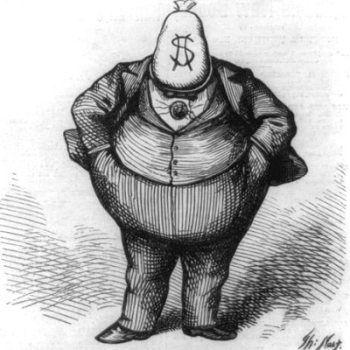Some thoughts on "tax day."
1. First things first: This is not "tax day." It's income tax day.
This is a minor point with major repercussions. Business reporters and politicians use "tax" and "income tax" interchangeably. Thus today is "tax day." Politicians who cut the income tax are "tax cutters."
This is partly a matter of convenience — you save two syllables by just saying "tax" when you mean "income tax." It's also a reflection of the economic status of most politicians and of big name reporters and their editors. They make enough money to be a part of the top 3/10 of American taxpayers for whom income taxes are a bigger share than payroll taxes, which take a much bigger bite out of the earnings of seven out of 10 of us.
For most of us, then, the most important "tax day" doesn't come on April 15 — it comes every two weeks.
Payroll taxes are regressive — a flat tax that applies only to the first $87,000 of wages. And it applies only to wages — not to income from dividends or interest. Income taxes are progressive (although less so than they used to be).
By using "tax" and "income tax" interchangeably, politicians and business reporters end up ignoring the actual tax burden facing most American households and they end up turning their tax-cutting attention primarily to the most progressive part of the code. Ronald Reagan signed into law the largest tax increase in American history, hiking payroll taxes to a new record-high level. Yet Reagan is remembered primarily as a tax-cutter because he cut income taxes.
2. Most American taxpayers (about 2/3) take the standard deduction on their income taxes. This is another fact you would never realize from reading the biz-page hype leading up to April 15.
This helps to explain why flat-tax zealots like Dick Armey and Steve Forbes met with so many blank stares when they spoke dreamily of some far-off day when most Americans could fill out a simple one-page tax return. Most of us already have a one-page return. In all likelihood, Forbes' chauffer fills out a one-page return.
3. I thought that I might break with tradition this year and actually itemize my return like the top third of taxpayers do. I had understood that health insurance premiums could be deductible.
Unfortunately, I'm told, this deduction can only be taken if you're buying your own health insurance because you're "self-employed." It doesn't apply to those buying it because they work for a miserly publishing giant that does not offer benefits to all of its full-time employees.
4. My paper today ran an irresponsibly lazy "tax day" piece by AP biz writer Mary Dalrymple. It has Dalrymple's byline, anyway, even though most of it was written by the antitax lobbying group National Taxpayers Union. The folks at NTU had to be mighty pleased to see so much of their press release reproduced so faithfully and uncritically.
The alleged news hook here is a new "study" by the union regarding the increased complexity of the tax code. Their basic point — increased complexity means more inefficiency, which is bad for the economy — is a no-brainer. To make this basic point more newsworthy, they provide "data" such as this:
The total estimated time to finish these common forms is 28 hours and 30 minutes.
It is not only frustrating, but economically counterproductive, said David Keating, senior counselor for the National Taxpayers Union and author of a new study on tax complexity.
"This is something that hobbles the nation's productivity because we have a lot of very talented people filling out paperwork," he said. "It's a real deadweight in our economy."
Even the simplest Form 1040EZ tax return takes an average of 3 hours and 43 minutes to complete.
Whaaaa?
Three hours and 43 minutes to complete the 1040EZ? This is, frankly, impossible.
The 1040EZ takes, at most, a half-hour to complete. I finished mine in less than 10 minutes without a calculator and without turning off the TV.
Seriously, nearly 4 hours? Here's what's involved in filling out the 1040EZ:
A) Two elementary arithmetic problems. (Subtract a 4-digit number from a 5-digit number. Calculate the difference between two other 4-digit numbers.)
B) Looking up the amount of taxes owed in the booklet — a task slightly less challenging than looking up the number of the pizza place in the phonebook.
That's it. If you did all the arithmetic on your fingers and toes it still wouldn't take 3 hours and 43 minutes.
David Keating of the National Taxpayers Union: You're over the line. You hereby forfeit your right to be taken seriously.












